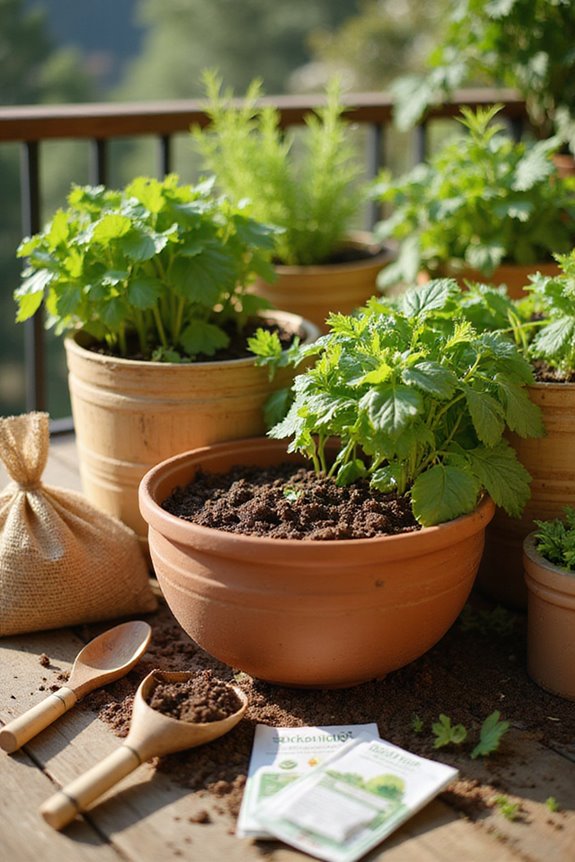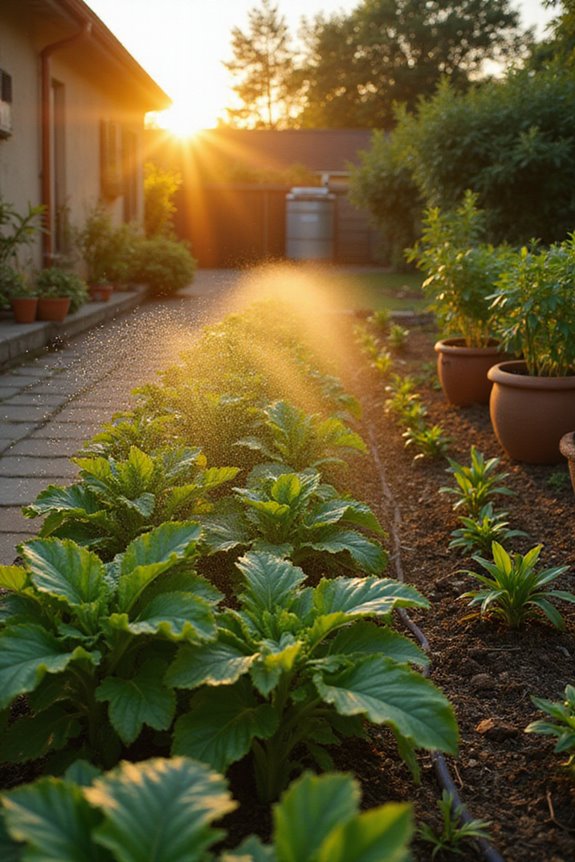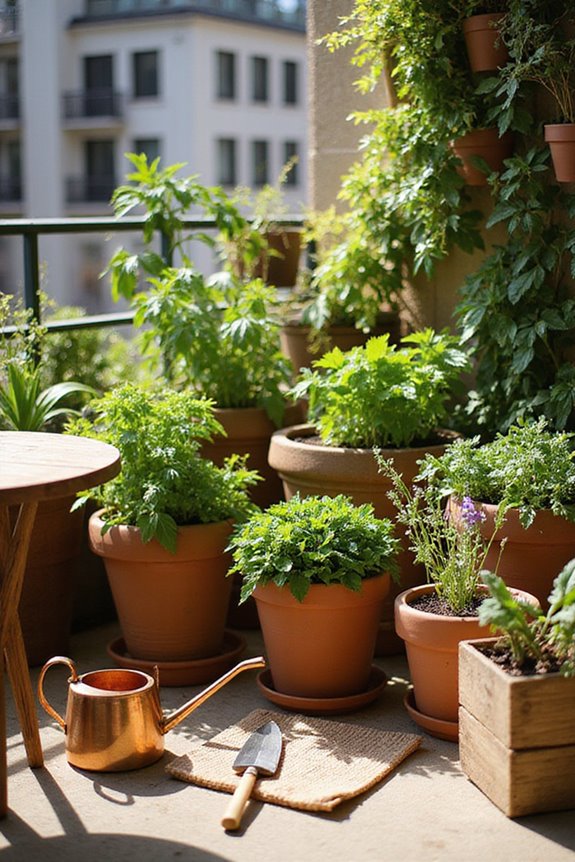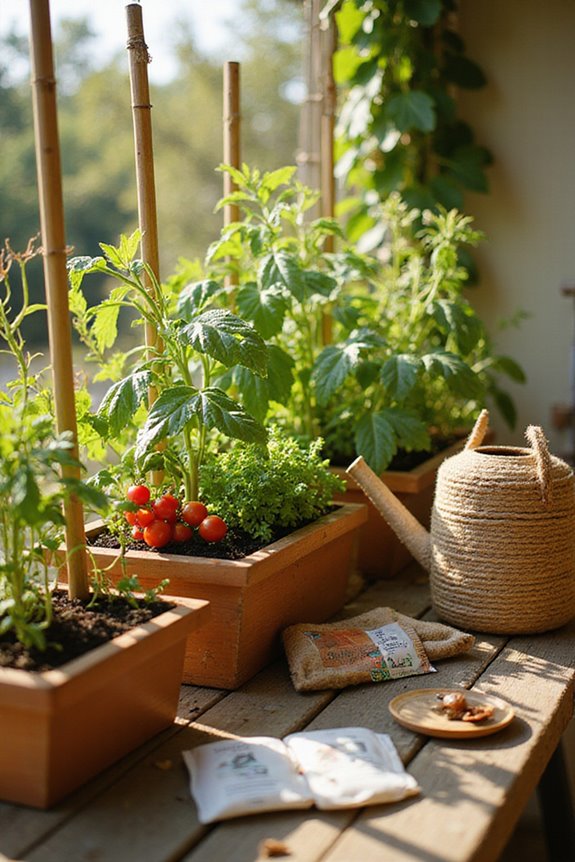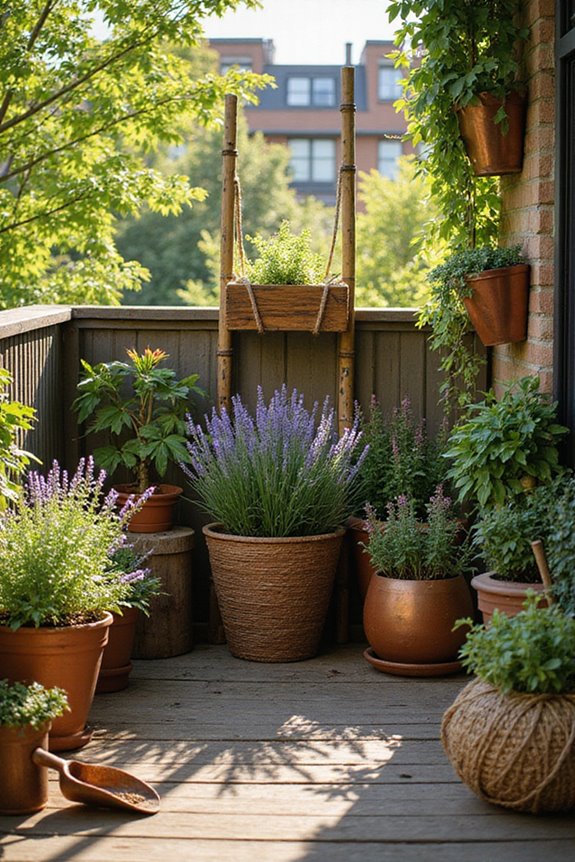For container gardens, we should consider both organic and synthetic fertilizers. Organic options improve soil health and provide essential nutrients, while synthetic options, like water-soluble and slow-release fertilizers, offer quick and consistent nutrition. We can apply 2 cups of organic fertilizer per cubic foot for healthy growth. It’s essential to time our applications well, typically 2 to 6 weeks after planting. By understanding the types and best practices, we can create thriving container gardens.
Key Takeaways
- Complete Fertilizers: Choose complete fertilizers with balanced N-P-K ratios for optimal plant growth in container gardens.
- Water-Soluble Options: Use water-soluble fertilizers for quick nutrient absorption, ideal for rapid recovery from deficiencies.
- Slow-Release Fertilizers: Opt for slow-release fertilizers to provide consistent nutrition and minimize the risk of nutrient spikes.
- Organic Fertilizers: Incorporate organic fertilizers to improve soil health and promote sustainable gardening practices.
- Regular Application: Apply fertilizers 2 to 6 weeks after planting, reapplying as necessary to replenish leached nutrients.
Understanding Different Fertilizer Types
When we think about container gardening, understanding different fertilizer types is essential for healthy plant growth. Various fertilizer formulations are available, each serving unique purposes. Complete fertilizers contain balanced nutrient ratios of nitrogen, phosphorus, and potassium (N-P-K), supporting overall plant health. We can choose between organic and inorganic options, which affect nutrient release rates and soil health differently.
Granular fertilizers are easy to apply and often provide a slow-release option, perfect for long-term nourishment. Liquid fertilizers act quickly, giving plants immediate nutrition when needed. Slow-release fertilizers gradually supply nutrients, reducing the risk of over-fertilization. By knowing these types, we can better tailor our approach to meet our plants’ specific needs, fostering a thriving container garden together. Additionally, incorporating high nitrogen fertilizers can significantly enhance growth, especially for plants like bamboo.
Benefits of Water-Soluble Fertilizers
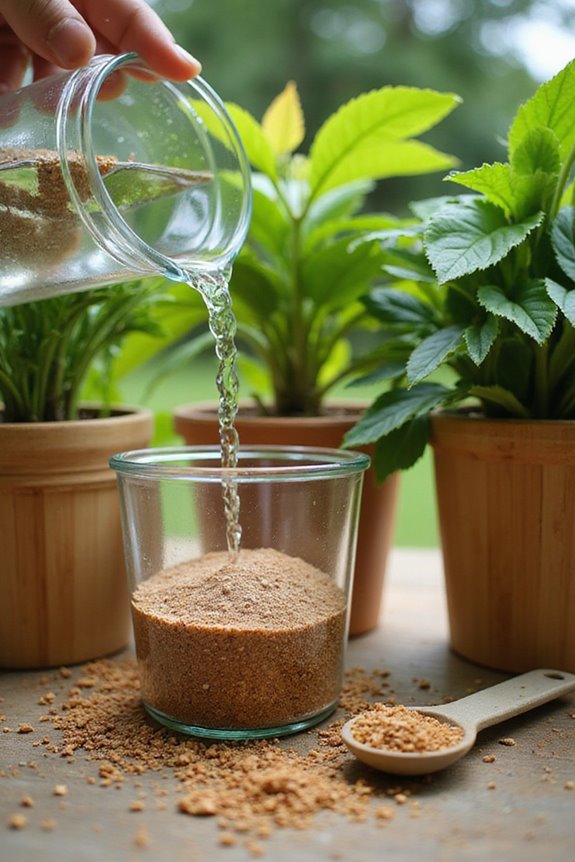
Water-soluble fertilizers offer numerous advantages for container gardens, enhancing plant growth and health. First, they provide quick nutrient absorption, allowing plants to quickly recover from deficiencies and stress. This is especially beneficial for container gardening, where nutrients can be limited.
Moreover, these fertilizers come with tailored formulations. We can adjust application rates to meet specific plant needs, ensuring balanced nutrition throughout the growing season. This versatility allows us to use weaker solutions for seedlings and stronger mixes for mature plants.
Additionally, water-soluble fertilizers promote uniform distribution in the potting medium, preventing nutrient-rich or poor spots that could harm our plants. Overall, their ease of use makes them an excellent choice for all types of container gardens.
Advantages of Slow-Release Fertilizers
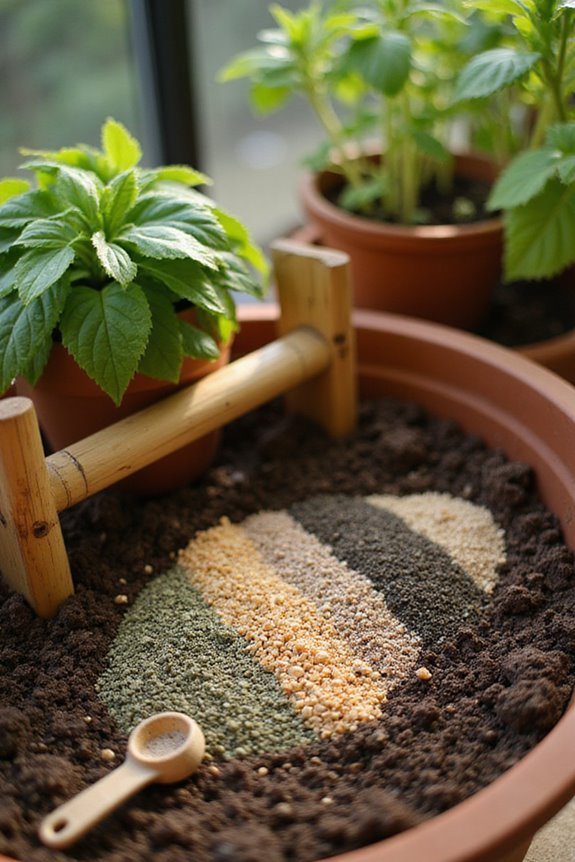
Slow-release fertilizers offer several distinct advantages for container gardens that can greatly enhance plant health and growth. To begin with, they provide a consistent, gradual release of nutrients, ensuring nutrient efficiency and preventing spikes that can stress our plants. This steady supply reduces the risk of nutrient burn, promoting healthier roots and vibrant flowering.
Secondly, they minimize nutrient leaching, supporting environmental protection by reducing runoff that harms waterways. This means we’re using fertilizers more responsibly and sustainably.
Lastly, slow-release options require fewer applications, saving us time and effort. With a balanced mix of nutrients, they help our plants thrive without the worry of imbalances. Overall, these fertilizers are a convenient and effective choice for any container gardener.
The Role of Organic Fertilizers in Container Gardens
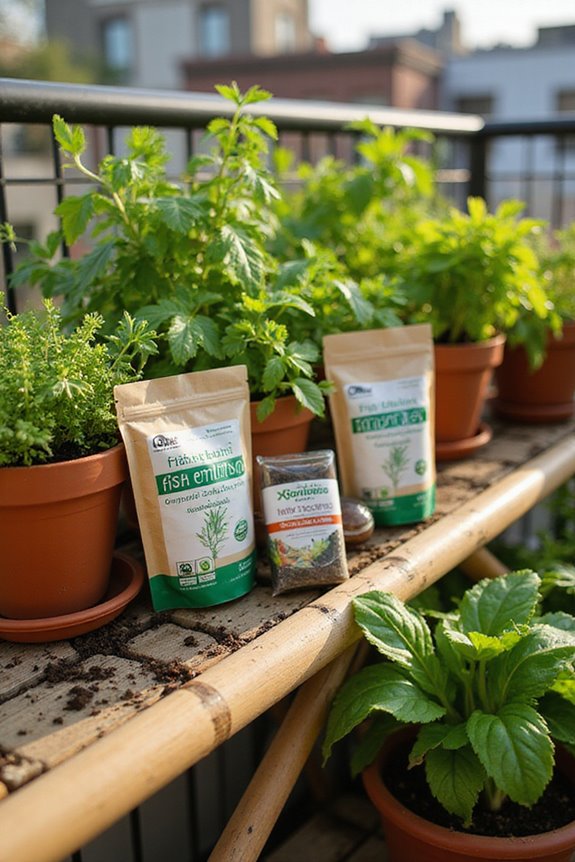
Organic fertilizers play an essential role in container gardens, offering a natural way to nourish our plants. They supply crucial nutrients like nitrogen, phosphorus, and potassium, promoting healthy growth. These fertilizers enhance nutrient retention in the soil, reducing the risk of leaching.
1. Improved Soil Health
Organic fertilizers improve soil structure and aeration, supporting root development. They also boost microbial activity, which helps break down nutrients for easier plant uptake.
2. Sustainable Practices
By using organic options, we reduce our reliance on synthetic chemicals. This supports a balanced ecosystem and minimizes environmental impact.
3. Long-Term Benefits
While results may take longer to appear, organic fertilizers provide lasting nourishment, ensuring our plants thrive over time.
Comparing Synthetic Fertilizer Options
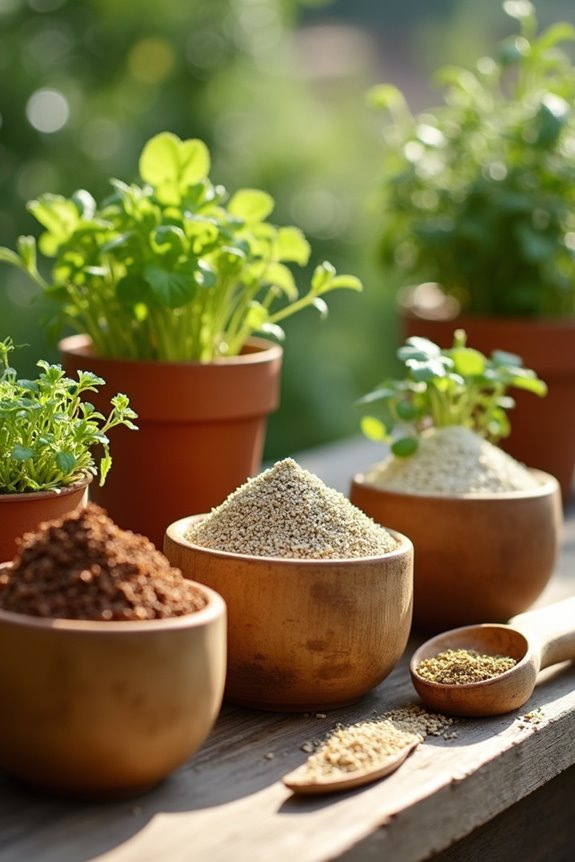
When choosing fertilizers for our container gardens, we often find ourselves weighing the benefits of synthetic options. These fertilizers come in various forms, such as liquids, powders, granules, and spikes. Each type has its unique advantages, helping us cater to our plants’ specific needs.
Synthetic formulations offer high nutrient concentrations with clear nutrient ratios, making it easier to manage our plants’ health. For instance, urea (46-0-0) provides quick nitrogen, while superphosphate (0-18-0) supplies phosphorus for blooming plants.
However, we should remember that some options may have burn potential if not applied correctly. To sum up, understanding the different synthetic fertilizers allows us to make informed decisions for thriving container gardens.
Best Practices for Fertilizer Application
Applying fertilizer correctly is key to maximizing the health and productivity of our container gardens. Here are some best practices to follow:
- Fertilizer Timing: Start applying fertilizer 2 to 6 weeks after planting. Adjust this based on how quickly our plants are growing and the type of potting media used.
- Application Depth: Mix fertilizer into the top 6 inches of soil. Roots and nutrients primarily reside near the surface, so deeper mixing isn’t necessary.
- Nutrient Absorption: To avoid over-fertilization, use conservative amounts—about 2 cups per cubic foot of soil for organic fertilizers. Regularly reapply as watering leaches nutrients, and always water in fertilizers to help with even distribution.
Frequently Asked Questions
How Do I Know if My Plants Need Fertilizer?
We can tell our plants need fertilizer by watching for nutrient deficiencies like yellowing leaves, stunted growth, or weak stems. If we notice these signs, it’s time to boost their nutrition for better plant growth together.
Can I Use Fertilizer on Seedlings?
Absolutely, we can use fertilizer on seedlings, but let’s be gentle. They have specific nutrient requirements, so starting with a weak dilution helps guarantee healthy growth. Together, we’ll nurture our little plants to thrive!
What Signs Indicate Over-Fertilization in Plants?
When we see yellowing leaves and stunted growth, it’s like watching our plants struggle in silence. Recognizing these signs of over-fertilization helps us nurture them back to health, fostering a thriving garden we can all cherish.
Are There Any Homemade Fertilizer Options?
Absolutely, we can create homemade fertilizers! Compost tea made from kitchen scraps and banana peels is a fantastic option. It nourishes our plants while reducing waste, making our gardening journey more sustainable and fulfilling together.
How Often Should I Test My Soil for Nutrients?
Imagine our garden as a canvas; just as artists check their paints, we should test our soil every few years to understand nutrient levels. Regular soil testing keeps our garden thriving and vibrant, together.

